ERE week 2 - Market instruments & dynamic efficiency
1/40
There's no tags or description
Looks like no tags are added yet.
Name | Mastery | Learn | Test | Matching | Spaced |
|---|
No study sessions yet.
41 Terms
The problem with pollution
Its a negative externality
Coase theorem not applicable to most enviro problems
Govt has to intervene
Direct / command & control regulation
Control firms output of negative externalities via laws and regulations - Govt in control
Tell firms by how much (and how) to reduce pollution
2 firm pollution diagram
Reducing emissions costs firms → Cheapest emission reduction methods used first but get increasingly more expensive
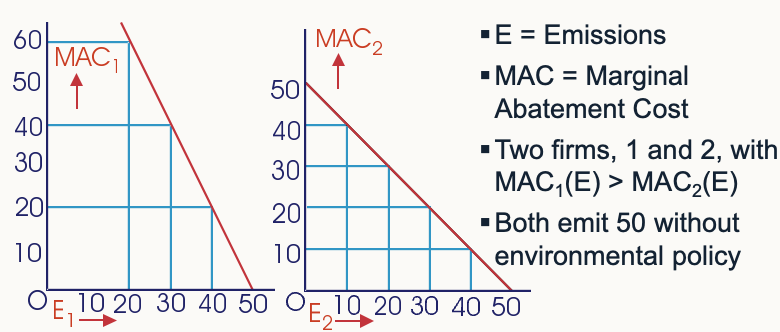
2 firm pollution diagram - Govt caps firm emissions
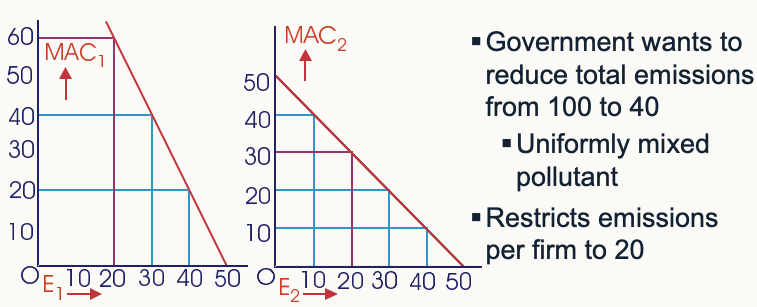
Uniformly mixed pollutant
Damage from pollutant doesn’t depend on where the emissions are
2 firm pollution diagram - Optimal pollution
Lower MAC for firm 2 - optimal for it to pollute less
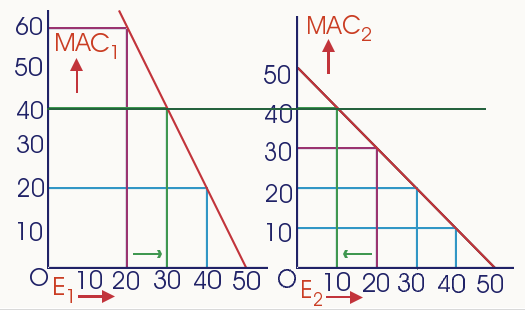
Optimal pollution level
Where MACs are equal
minimises overall costs
Problems with optimal / efficient pollution for Govt
Need to know firms individual MAC
Firms don’t have incentive to find out and disclose
Tradable emission permit system
The govt allocates permits for both firms to emit a certain level of E but the firms can trade them
2 firm pollution diagram - Tradable permits
Govt allocates permits for both to emit 20 (wants E = 40)
Cheaper for 2 to cut E so they sell permits
2 sells permits until MAC1 = MAC2 = permit price
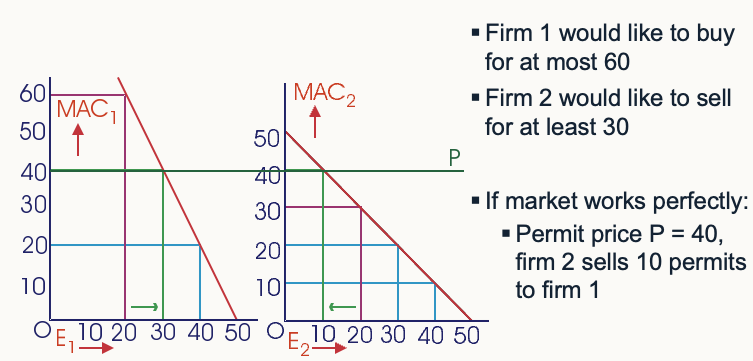
How to introduce tradable permits
Grandfathering - Distribute permits for free among incumbent firms
Auction - permits sold to highest bidder
Trading results in the efficient permit allocation, whatever the initial distribution
2 firm pollution diagram - Emissions taxation
Firms choose between paying tax and abatement (reduces T paid)
Set MAC = T
Each firm has different E & T
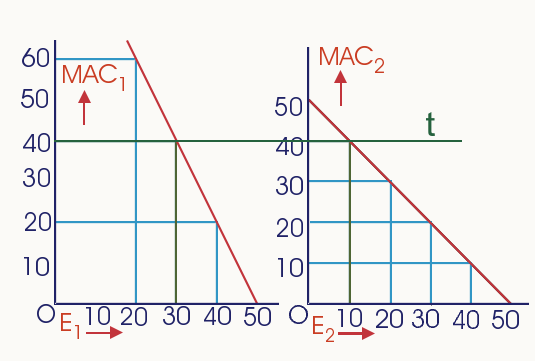
2 firm pollution diagram - Abatement subsidy
Firm paid to reduce emissions below a baseline
Firms reduce emissions till subsidy rate (s) = MAC
past s its more expensive to reduce emissions than you gain from the subsidy
Costly to Govt
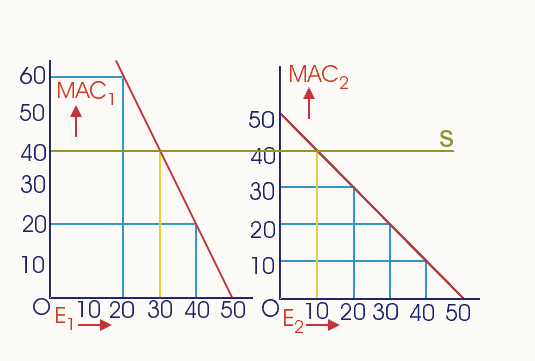
Market instruments vs Direct regulation
Market:
Govt only needs to know aggregate MACs
Tradable - Emission target always met if cap enforced
Costs not known in advance
Tax - Emissions may be above or below target
MAC known in advance
Direct
less cost effective
Are permit trading outcomes independent of allocation?
Theory - Permit trading leads to efficient allocation whatever initial allocation
Can use initial distribution for political means – most permits to firms that lobby
Strong correlation between initial allocation and ultimate emissions - TC and regulatory uncertainty? CORRELATION ≠ CAUSATION
RECLAIM programme example - overview
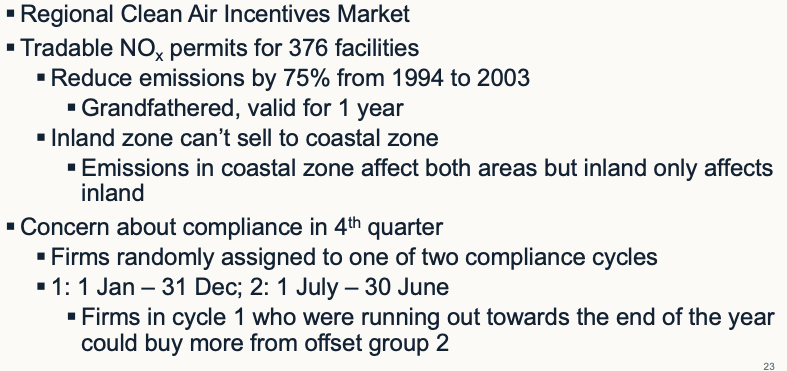
RECLAIM programme example - TC & regulatory uncertainty
Firms had to learn about programme, abatement costs and how it works
Broker fees to buy through a broker (1-3%)
Questionable broker practices as well – brokers never sourced the permits
RECLAIM programme example - Allocation & E overtime

RECLAIM programme example - Empirical test (does allocation affect E)
Dependent variable - Log E (per firm + per 6 months)
Explanatory variable - Initial permit allocation
Results - Only explan var (0.79***) OR Include final allocation (0.65***) OR include wage and PPI (0.65***)
Initial permit allocation affects E
RECLAIM programme example - Instrumental variables
Maybe firms exploit the existence of 2 cycles - If random assignment then cycle 2 firms no higher E
Regress allocation on Time & Fixed effects + cycle dummy
allocation no longer significant
Empirical findings are consistent with, but not proof of, independence property
Uncertainty about abatement costs
Tradable permits
Certainty about reaching emissions target – emissions are valuable and firms want to maximise production
Uncertainty about costs - More / less permits should be issued if cost higher / lower than expected
Taxation
Uncertainty of reaching emissions target - If abatement costs higher than expected, then emissions higher than expected – higher tax rate needed
Certainty of what MAC - Firms set MAC = t
Taxes vs permit diagram - initial diagram
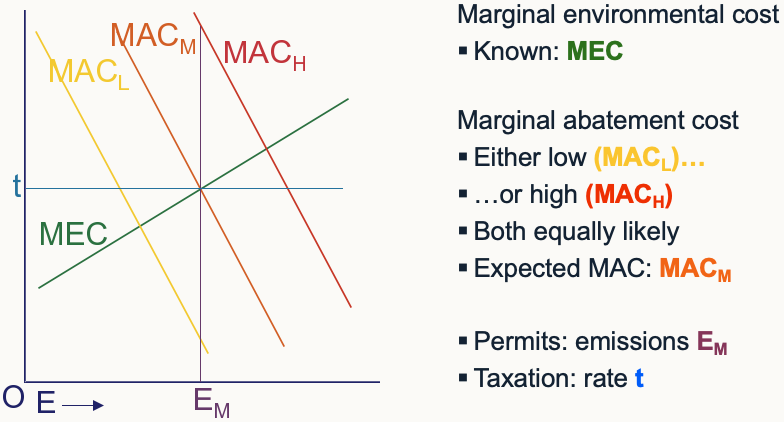
Taxes vs permit diagram - permits
Too many or too few permits issued
Total welfare loss = ½ of high welfare loss + ½ low welfare loss
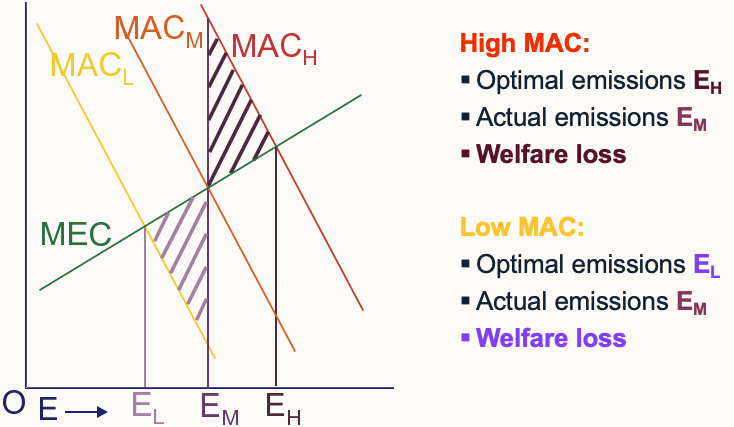
Taxes vs permit diagram - tax
Optimal emissions is different to where firms optimally choose
Firms choose where t = MAC
Social optimal is where MEC = MAC
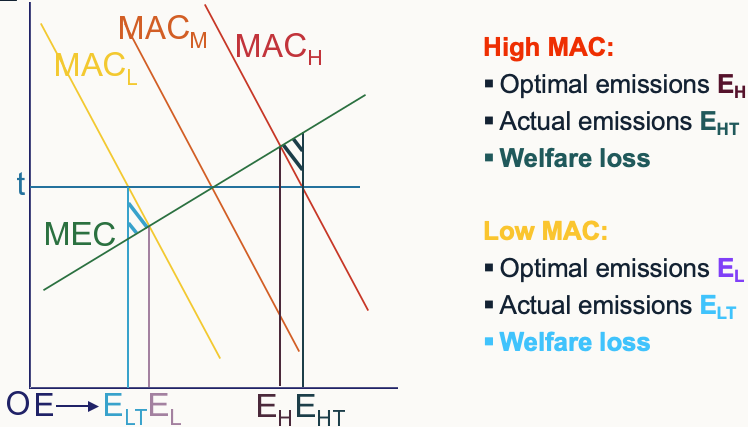
Taxes vs permit diagram - comparison
Optimal depends on slope of MAC and MEC
When MAC steeper than MEC – taxes better
MEC uncertain for both methods unlike MAC

Spatial dimension theory - overview
Assumptions
1 & 2 have same MAC
Environmental damage function same in A & B
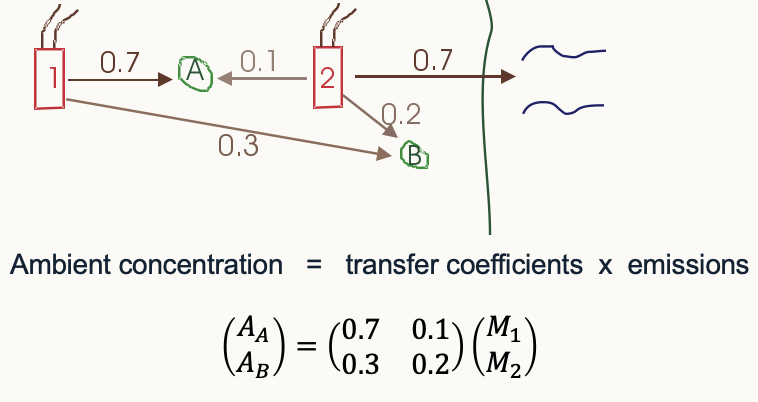
Spatial dimension theory - tax
Same tax rate for both firms
BUT 1 does more damage so should have higher tax rate optimally
All E from 1 ends up in A or B
If worked out then you might as well impose direct regulation and so all benefits lost of market
Spatial dimension theory - permits
1-to-1 trade
Both firms emit same amount
Too much pollution from 1 in A & B
Ambient permits
Permits used in term of conc at receptor point A or B
Firm 1 wants to increase emissions by 10: Needs 7 permits for A, 3 for B
Lower administrative cost than taxation - set E cap and let firms trade
Higher TC
Not yet tried in real life
US air pollution example - overview
Pollutants captured from 10k point sources (country aggregated ground sources)
Source-receptor matrices give county-level concentrations
Exposures = concentration x populations (people, crops etc.)
Damages - Market price, Human health, valuation studies
US air pollution example - Marginal damages
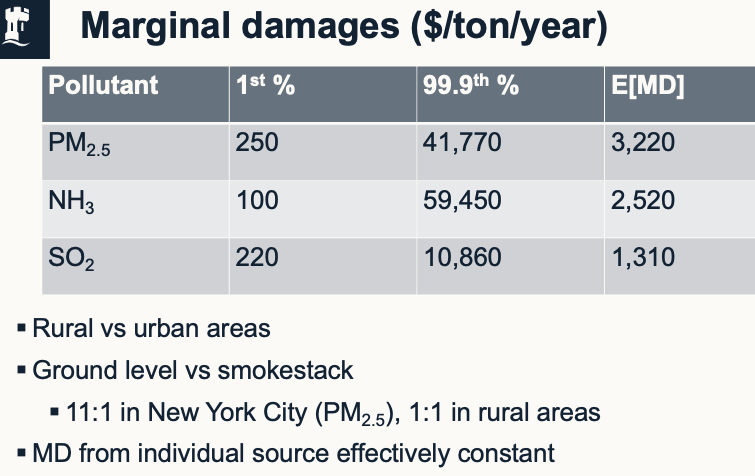
US air pollution example - SO2 marginal abatement costs
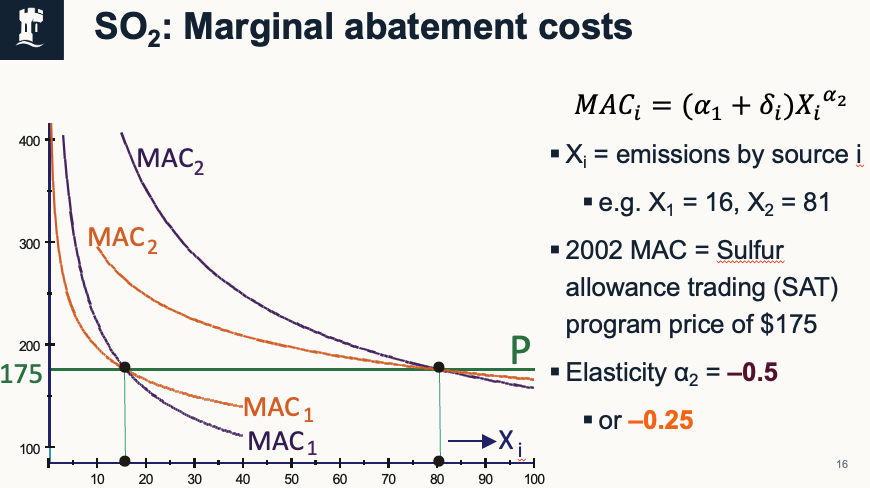
US air pollution example - Welfare gains

Dynamic efficiency
Incentive to do R&D into and adopt new technologies
→ New tech lowers E
Dynamic efficiency graph - initial
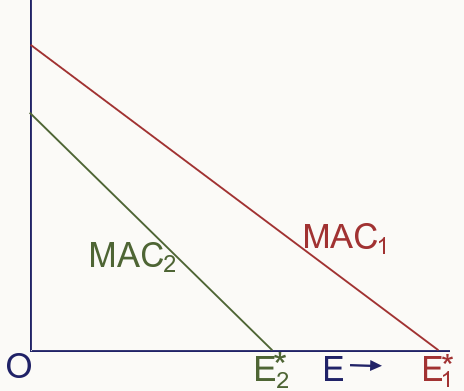
Dynamic efficiency graph - Direct regulation (E1)
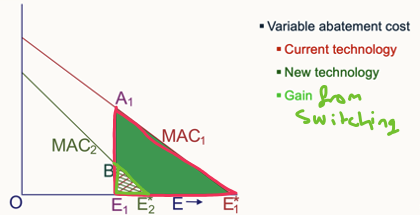
Dynamic efficiency graph - Tax / auctioned permits
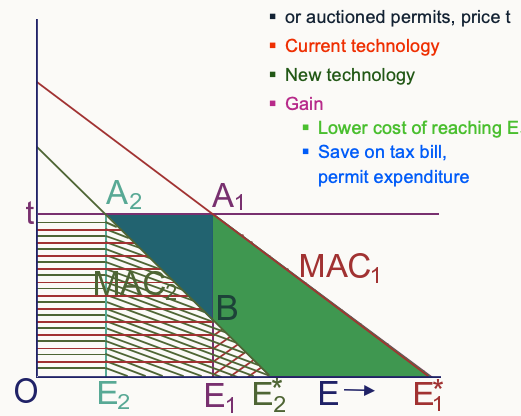
Dynamic efficiency graph - Tax / auctioned permits
Dynamic efficiency graph - Direct vs market
Market instruments have additional gain of net saving on tax bill / permit expenditure
• Reducing emissions to E2 gives higher abatement cost (area below MAC2)
• More than compensated by saving in tax bill
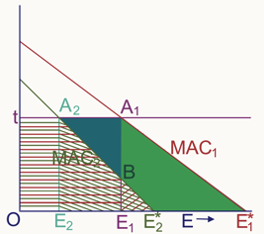
Dynamic efficiency graph - Grandfathered permits
With new tech still get E1 permits → Can sell excess at price t
Regulator may see the switch to new tech and give firm E2 permits in the future → Reduces incentive to switch

Dynamic efficiency graph - Abatement subsidy
Firm paid D → Paid more by reducing E
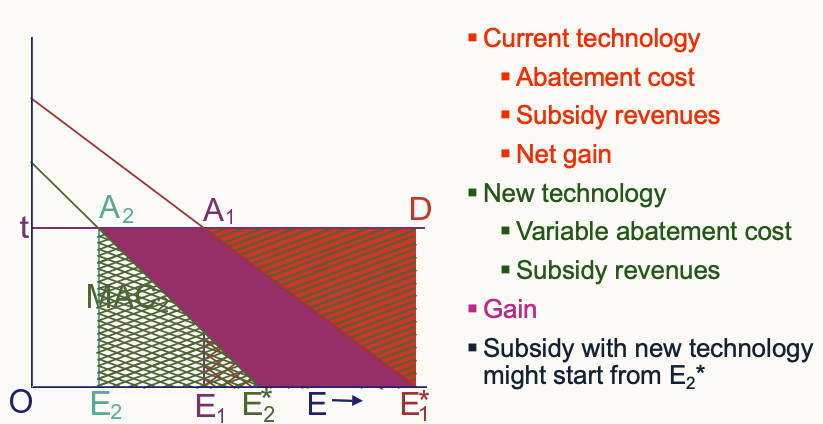
Dynamic efficiency summary
E tax + Auctioned permits give highest incentives for new technology adoption
Abatement subsidies + grandfathered permits also give these incentives (if baseline remains the same)
These high incentives for adoption are optimal
New technologies make it worthwhile to reduce emissions further - Firms should be rewarded for this gain